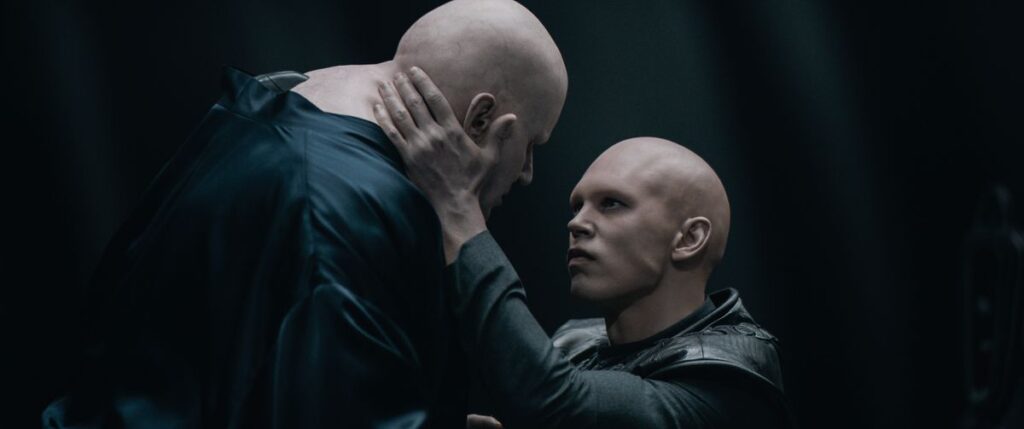Denis Villeneuve’s Dune movies can seem like a rebuke to Hollywood’s quip era. They are as far as you can get from the Marvel rule that no situation is so grave, no stakes so high that they can’t be punctuated by a smart, self-aware gag. These are solemn, earnest movies, modeled on classical cinematic epics like Lawrence of Arabia and intent on delivering the bizarre visions of Frank Herbert’s sci-fi books in as straight-faced a manner as possible.
Except, for Dune: Part Two, Villeneuve and his collaborators seem to have realized that a little bit of levity goes a long way. One of the reasons this movie is quite a lot more enjoyable than the first — alongside its more even and purposeful dramatic structure, and the fact it wasn’t released in the middle of a pandemic — is that Villeneuve has figured out how to loosen it up a little without puncturing the mood. With much of the visionary world-building work already done, he could afford (or, perhaps, was told by studio bosses) to sprinkle on a little bit more crowd-pleasing bits of business.
That’s evident in the film’s two most memorable turns: Javier Bardem’s Stilgar, and Austin Butler’s Feyd-Rautha Harkonnen. It would be unfair to call them camp, but these two actors do bring a vivid, outsized performance style that can hold its own amid the grandiosity of Villeneuve’s images or the boom and clatter of Hans Zimmer’s score. They do more than hold their own, in fact — they accentuate a windswept, monolithic movie with a much-needed note of fun and wickedness.
Bardem is the biggest surprise of Part Two, if only because little about his stoic performance in Part One would have led you to suspect that he would play the sequel for out-and-out lols. Stilgar is still the cool and courageous leader of the Fremen, but Bardem lightens the character with a recurring bit about his fanatical belief that Paul Atreides (Timothée Chalamet) is the Lisan al Gaib, a messianic figure prophesied to deliver freedom to the Fremen.
Like a character from Monty Python’s Life of Brian, Stilgar jumps on any evidence, no matter how contradictory, that Paul is the chosen one — from his choice of Muad’Dib, a tiny desert mouse, as his Fremen warrior name (“It’s perfect!”) to his insistence that he is not the Lisan al Gaib at all (“Only Lisan al Gaib would be so humble!”). Bardem’s comic timing and wide-eyed, credulous conviction invariably bring the house down; it’s such a good running joke that it ran straight out of the movie and became a meme.
MVP of Dune Part Two for me is Javier Bardem, who has surely let a middle eastern uncle who owns a corner shop that has the tv on all the time on horse race channel take over his soul to achieve that performance. Incredible to witness. He is no longer Spanish to me.
— Ege Elbir (@egeofanatolia) March 3, 2024
But Bardem isn’t mocking Stilgar. The character’s passionate need to believe is a note of fallible but touching human optimism in a movie more often concerned with political scheming so entrenched that it spans centuries. We laugh at Stilgar, but it’s a fond laugh of recognition and identification — we’d rather be him than almost anyone else in the movie.
That’s not true of the other standout performer, who exists at the other end of the spectrum of broad movie archetypes from “favorite uncle.” As Feyd-Rautha, Butler is pure, cartoonish evil: the sadistic, pampered nepo baby of the evil Harkonnen empire. Butler shot Dune: Part Two around the same time Elvis was in theaters, but before his breakthrough performance in that movie had swept him as far as an Oscar nomination, and his hunger to make an impression radiates off the screen.
To his credit, he doesn’t try to invest Feyd-Rautha with nuance or psychological complexity. He understands that the assignment is iconic, two-dimensional, literally black-and-white movie villainy. The performance is more about looks and physicality than anything else. Butler’s lanky frame assumes a spidery aspect; he moves and strikes with a slithering viciousness in the fight scenes. His pretty-boy looks are transformed by a smooth skull cap that comes down over his eyebrows into something repulsive in its nakedness — without losing their magnetic quality.
Image: Warner Bros. Pictures
Butler’s boldest transformation is vocal, though: an uncanny imitation of his co-star Stellan Skarsgård’s accent, intonation, and phrasing. (Skarsgård plays Feyd-Rautha’s uncle, the big bad Baron Vladimir Harkonnen.) Doing an impression of a legendary character actor to their face is a hell of a choice for a young actor to make in a big, high-stakes movie, and it could have backfired, but it pays off both dramatically — showing how Feyd-Rautha’s uncle has shaped him in his own image — and as a kind of acting special effect. It’s creepy, weird, and alien, as well as being an entertainingly bold gesture in its own right. Like so many great movie villain performances, Butler’s Feyd-Rautha is full of relish in a way that’s right on the border between intentionally and unintentionally funny. (Skarsgård was certainly tickled by it.)
There are other great performances in Dune: Part Two — Chalamet and Rebecca Ferguson both pull off plausible and unsettling character transformations over the course of the film. Zendaya, meanwhile, quietly but sure-footedly asserts herself as the soul of the movie in a true star performance. But Butler’s and Bardem’s old-fashioned ham just pops off the screen. They’re exactly what you need from a supporting character in a monumental epic: some bigness of the actorly kind, to match the hugeness of everything else.

